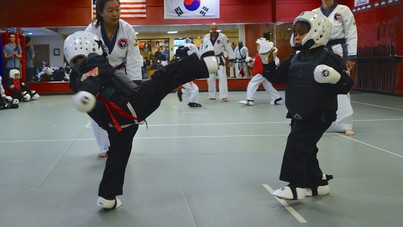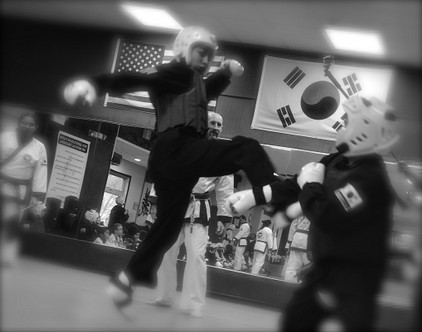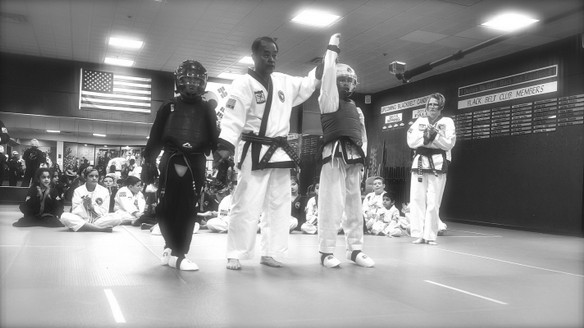Tang Soo Do
The Art
Korea has a long history of civilization. Like all ancient civilizations, it has periodically engaged in military activity. This has led to the building up of a martial tradition extending up to now.
During the 4th Century AD, wandering monks from China introduced Buddhism to Korea. Some of these were accomplished martial artists. Indeed, they had to be for their own safety. There are reliable records of them teaching people martial arts.
The art of Korean Tang Soo Do can be traced back to a period of time when Korea was divided into three Kingdoms. After a long series of wars, the Silla Dynasty united the three kingdoms in 668 AD. The Silla Dynasty, 668 A.D-953 A.D., was a period when the martial arts expanded rapidly in Korea. It was noted for the military progress of its young  warrior class; the Hwa Rang. The basic principles of Tang Soo Do, the Path of Virtue and duty, harmony with the nature of the universe, knowledge and understanding of geography, great leadership, and social system and order are derived from the ten principles on mental training of these elite warriors: be loyal to one's country; be obedient to one's parents; be loving to one's husband or wife; be cooperative with one's brothers; be respectful to elders; be faithful to your teacher; be faithful to your friends; kill only in justice and with honor; never retreat in battle; and always finish what you start.
warrior class; the Hwa Rang. The basic principles of Tang Soo Do, the Path of Virtue and duty, harmony with the nature of the universe, knowledge and understanding of geography, great leadership, and social system and order are derived from the ten principles on mental training of these elite warriors: be loyal to one's country; be obedient to one's parents; be loving to one's husband or wife; be cooperative with one's brothers; be respectful to elders; be faithful to your teacher; be faithful to your friends; kill only in justice and with honor; never retreat in battle; and always finish what you start.
After the Silla Kingdom, the Koryo Kingdom was formed and the Yi Dynasty (A.D. 1390-1907) was formed. At the Yi Dynasty, the National Martial Arts manual, Moo Yei Do Bo Tong Ji, was published.
Following the liberation of Korea in 1945, the Moo Duk Kwan (Institute of Martial Virtue) and four other martial art schools were formed. Four other schools are Ji-Do Dwan, Chung-Do Kwan, Song-Moo Kwan, and Chang Moo Kwan. The Moo Duk Kwan and Ji-Do Kwan later formed the Korean Soo Bahk Do Association (Tang Soo Do) in 1960 to develop the study and practice of traditional Korean Martial Arts. Tang Soo Do has since spread throughout the world.
Tang Soo Do will develop and teach you to have a feeling of security through physical fitness, poise, grace and sporting un-armed self-defense. Most importantly, Tang Soo Do will provide peace of mind, sense of self-discipline and a sense of self-confidence. Consider the following aspects of this unique art:
Mind - Tang Soo Do is essentially the art of self-defense. This is acquired through training the mind over body. Karate is never to be used wrongly or violently.
Spirit - Because Tang Soo Do is non-violent, patience and restraint in daily affairs must be cultivated. The misuse of this art would greatly endanger our society; therefore in seeking something deeper than physical cultivation, we strive for mental discipline and self-confidence and peace of mind it brings.
Body - No one was born with a particularly strong body and spirit. It has to be developed. And like a moving machine, the body needs exercise and lubrication to keep it running smoothly. Tang Soo Do provides the stimulus, the exercise and the discipline for a lifetime of healthy activity.
Tang Soo Do is an ancient martial art which originated 2,000 years ago in Korea.
Tang Soo Do is a method of empty hand, and foot and weapon fighting, based upon the scientific use of the body in self-defense. Technically, Tang Soo Do is based upon the principles of yielding, circular motion, and penetration. Applications of the Tang Soo Do movements to a human's weakest points (vital points) will have no equal in power or effectiveness. The reputation for superior kicking techniques and development of the legs is a proud asset of Tang Soo Do.
Today, the techniques and philosophy are still taught as they were in ancient times, although the system has adjusted to the physical needs of modern lifestyles. Most of all, this mysterious art is designed to develop individual character, mental strength, integrity, and respect for others.
The eight key concepts of Tang Soo Do (Jung Shin Kwan)
Courage
Concentration
Control of Power
Endurance
Honesty
Humility
Speed Control
Tension and Relaxation
 On the average, millions of people invest thousands of dollars and much time into various health clubs in pursuit of better health. Achieving real "health" means not only physical conditioning, but improving psychological and spiritual attitudes.
On the average, millions of people invest thousands of dollars and much time into various health clubs in pursuit of better health. Achieving real "health" means not only physical conditioning, but improving psychological and spiritual attitudes.Self Defense - Ever since human history began man has needed to learn how to defend himself; to protect himself, his family, his possessions and his honor. Even today, investing some of your time in studying a self-defense system is indispensable insurance against the hazards of modern living.
Physical Fitness - Getting into shape is not just a luxury, but a necessity for maintaining good health. Tang Soo Do, gives you thousands of years of oriental wisdom and experience in ways of maintaining human health.
While learning techniques for self-defense, Tang Soo Do students will also be increasing flexibility, strength and coordination. Tang Soo Do includes cardiovascular aerobic exercise for the heart and lungs which will help students lose any excess weight. Don't worry about age (Tang Soo Do starts people in their sixties) or present physical condition, the instructors are experts in helping people of all ages to firm up and develop physically and mentally at a pace suited to each individual. No experience or background is needed.
Mental Strength - Physical exercise is a proven method for the reduction of tension and stress. Tang Soo Do emphasizes many different mental attributes as well as physical. Students are trained to incorporate mental concentration, self-discipline and respect for others, not only in their practice sessions, but in all aspects of their lives.

